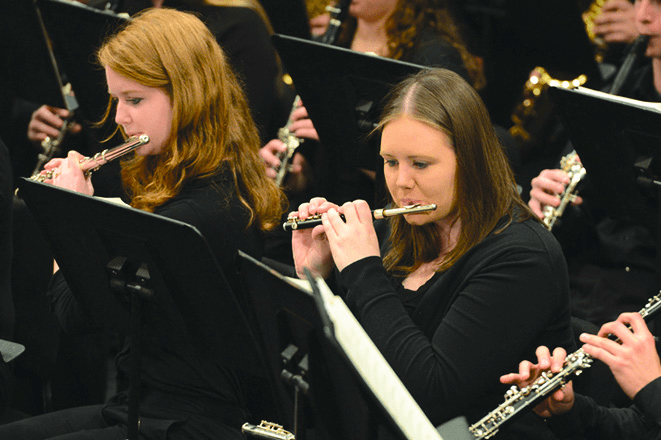By ADAM FALLUJI – STAFF WRITER
Centre’s orchestra is always an active ensemble, with many students continuing to hone their music skills from high school. Sitting in the front row of the entire ensemble, the flautists are a unique component of the orchestra.
The flute is a reedless woodwind instrument and the oldest-known musical instrument. While each instrument has its quirks, choosing one is a largely personal and instinctual process.
“I actually started on piano for a few years and then I was shown a demonstration of each instrument in an orchestra when I was young,” first-year Cara Barnett said. “I tried the trumpet and flute but I just felt more naturally inclined towards the flute.”
As the highest-sounding instrument in an orchestral ensemble, playing flute can be subject to particularity. However, there’s an effort to make the environment for musicians at Centre as stress-free as possible.
“Auditioning for the orchestra is a pretty painless process,” senior Katie Thompson said. “Jaemi Loeb, our conductor, is happy to have anyone who wants to play and the audition is mostly just to determine which players would be best-suited for certain parts. Many of the flute players actually get to alternate between parts so that everyone gets the chance to sit first- chair and play the lead part.”
A number of students at Centre attend with the aid of music scholarships. Students living far from Danville can send in audition tapes, and write an essay describing their interest in music. When they arrive in the fall, they have a laid-back audition for Professor Loeb.
Students with musical inclinations are greeted with an open welcome in the music department.
“The orchestra and wind ensemble, like all music program ensembles, are one credit, pass-fail courses that are open to everyone on campus.” Loeb said. “We do our best to make sure to find a place for everyone who wants to play or sing, no matter what their level. We are always looking for new members and we want everyone to know that continuing with music can make a real difference in their education while also enriching their lives.”
Music certainly becomes a big part of the lives of orchestra members, including regular rehearsals and eagerly anticipated concerts.
“Playing in concerts is great because we work hard all semester and our concerts are the only times when we can demonstrate what we have achieved. The most rewarding thing about playing the flute in the orchestra is that it is a great stress reliever from the pressure of classes. Rehearsals are a set amount of time every week when I have to focus on something other than exams and papers, and they allow me to bring out my more creative side,” Thompson said.
Not only can Thompson explore her own creativity, but she can enjoy the creative company of the flute section and orchestra as a whole.
“It is great to be able to meet with a group of people twice a week that share my same interest in making music, and the rehearsals are relaxed and fun. I love being able to participate in a group that can work together to achieve something great every semester.”
This term will be a busy one.
“There are a lot of exciting things going on in orchestra this term,” Loeb said. “As we do every spring, we have winners from our December concerto competition performing as soloists with the orchestra. This spring, sophomore soprano Emilie O’Connor will be performing “Exsultate Jubilate” by Mozart and first-year clarinetist Ben Finch will be performing “Five Bagatelles” by Gerald Finzi. Both of our soloists recently attended the Kentucky Music Educators Association Intercollegiate Music Festival where Finch was selected as principal clarinet based on his audition. The orchestra will also be going on its first-ever tour in April. We’ll be going to Nashville, TN where we’ll perform at the Nashville School of the Arts, participate in a clinic, and have some fun sightseeing.”
Flautists will have a particularly unique role in upcoming performances.
“Because of the instrumentation needs of our two concertos, our flute section doesn’t have quite as much work to do as is the norm in an orchestra. Unlike in a band, wind players in an orchestra are soloists. There is only one player on each part and they usually have short solos throughout each piece,” Loeb said.
Loeb believes that the orchestra’s flute section is truly versatile when it comes to taking on solos.
“Wind players always need to balance their roles as soloists with the needs of blending with their section and interacting with the other sections. So, it takes a high level of technical skills and sensitivity to play in an orchestral flute section,” Loeb said. “Our flute students at Centre are a particular joy to work with because they are willing and able to take on either this soloistic role or, when needed, a more team approach in our wind ensemble. They are all strong and versatile players and willing to play where/whenever they are most needed.”
Although they have to stay on their toes during performances and practices, the flautists find that it is easy to enjoy their role in the ensemble.
“I guess the real difference about being a flautist up front is that I like to think we have the best opportunity to hear what we sound like with everyone behind us,” Barnett said, “So when there’s a pretty moment, we get to hear it best, and we have the best opportunity to interact with the conductor.”
Next time you see the orchestra, remember to listen to the flautists.
